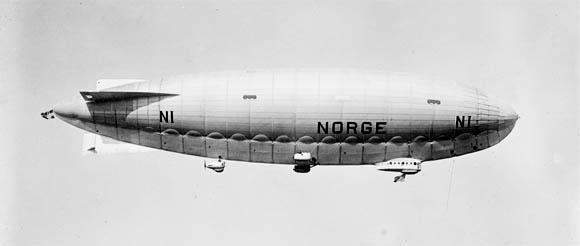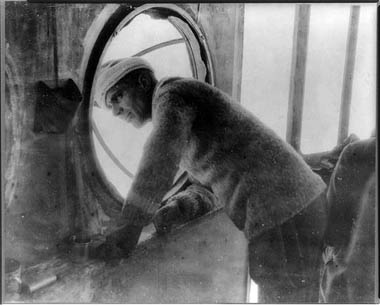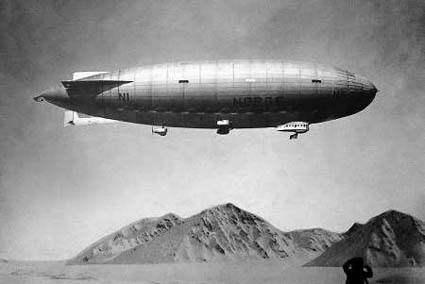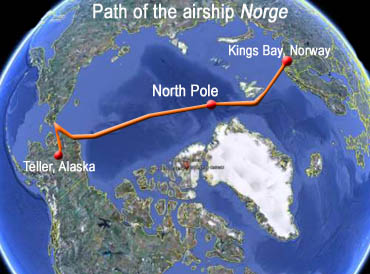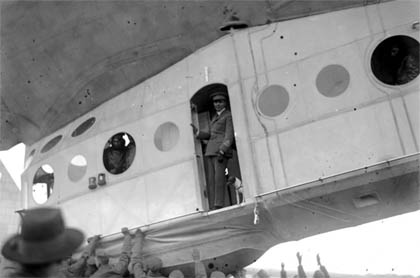pop up description layer
HOME
Cryptozoology UFO Mysteries Aviation Space & Time Dinosaurs Geology Archaeology Exploration 7 Wonders Surprising Science Troubled History Library Laboratory Attic Theater Store Index/Site Map Cyclorama
Search the Site: |
|
The Flight of the Norge (Part II)
From Part I: In May of 1926 a group of sixteen fearless adventurers boarded a small dirigible to fly over the North Pole. The audacious journey would be the first ever flight from the European continent to the American continent over the Arctic ice cap. The tiny lighter-than-air craft they piloted was named the Norge. The group successfully crossed the pole, but on the way to Alaska found themselves taken off course by the taunting vision mountains on the horizon. After changing course to investigate these hills, the mysterious mountains suddenly disappeared - just a trick of the air. Could the Norge find its way back on course safely? Ice Bullets Soon the crew had a lot more to worry about than just a mirage. The fog returned and the ship was forced to climb to 3,500 feet. Even worse, the clouds above began to drop and soon the two met. The Norge was now surrounded by an impenetrable white mist. Blinded, Nobile decided to take the ship down to see if the air was clear just above the pack. It wasn't. They were still flying visionless through a thick blanket of white. With the sun no longer visible, they couldn't be sure in what direction they were flying. They were navigating totally on instinct alone. Worse, the longer they stayed in the fog, the more the tiny water particles in the mist would start to freeze on the ship's exterior. In a few minutes this coating of ice was over an inch thick. If the airship was forced to stay in the fog long enough, the ice would grow so heavy on the exterior it would weigh the ship down, enough to send it crashing onto the forbidding wilderness of the pack. An even more immediate danger, however, was the ice clinging to the ship's exterior guide wires. As these vibrated in the wind, pieces of ice would break off and hit the spinning propellers. The propellers, in turn, would shoot these like bullets through the hull of the Norge making a sound like a gunshot. With each new "Bang!" the crew would scramble to put a rubber patch in place.
The ice also covered the ship's aerial and the windmill that powered the generator was frozen solid. With no power the radio was completlely out. If the aircraft was forced down onto the ice there would be no way to let rescuers know their position. Finally, early on the morning of May 13th, the crew of the ship caught a break. The sun broke through the clouds long enough for Riiser-Larsen to fix their position. Amazingly, they were still very close to their projected course. At this rate they could expect to see land sometime between six and eight A.M.. At 6:30 the navigator spotted what he thought was land off the port bow. At first he held his tongue, fearing it might be just another Arctic mirage. Soon, however, it was apparent to everybody they were crossing over the coastline of Alaska near Point Barrow. After 46 hours and 20 minutes, they had made it over the North Pole, crossing from the Old World to the New. With the weather clearing and land below, the crews' spirits soared. They had considered setting down at the small settlement at Wainwright near the coast, but decided to push on to their announced goal: Nome. This would turn out to be a mistake. A Near Miss with a Mountain Several hours later a violent storm rushed in from the north and drove the airship out to sea. They were almost over Russian Siberia before they could finally turn back, cross the Bering Strait, and again approach Alaska. As they closed in on American soil, however, the fog appeared again. Fearing a crash into the mountainous coast of Alaska, the crew sought a bit of clear air. After an hour it finally appeared. Nobile ordered the airship to follow the course of a ravine whose rugged edges jutted out of the fog below them. Suddenly, out of nowhere, a gale force wind appeared driving the Norge toward one of the hills that lined the ravine. The windows suddenly fogged up and Nobile took the wheel himself, ordering the navigator to stick his head out of the window to watch for the top of the ridge.
His warning nearly came too late, however, as a black wall of rock suddenly appeared in front of them. Nobile pulled the ship into a sharp climb. The top of the hill was so close that Noble thought for a moment that he might have lost an engine gondola on the rocks. A quick check by intercom with the engineers at each motor, however, reassured him that the ship was still intact. One of them named Pomella, however, said that his gondola came so close to the hill he could have reached out and touched its stony surface. Lost back up in the fog, Nobile was forced to again lose altitude so that he could make out the ravine in order to follow it. This resulted in more close calls with hilltops, however. By 4 PM the crew was so tired of dodging rocks that the airship was taken up to 3,000 feet to see if they could climb out of the fog and get a reading on their location. Dangerous Altitude They finally did rise above the clouds. The sun, however, was too high in the sky to get a reading from inside the control cabin. The gas bag above put everything below it in shade. Riiser-Larsen had to climb up the keel to the bow of the ship. He then had to scamper up a ladder on the outside of the vessel in the subfreezing air until he was on top of the gas bag. From there he could finally see the sun and get a position. While he was doing this the sun had an unfortunate effect on the gas inside the dirigible. The warmth caused the hydrogen to expand rapidly. This quickly increased the craft's lift and the airship's altitude. With less pressure further up in the air, the gas bag expanded even more. Within moments the envelope was in danger of being torn apart by the pressure. Nobile tried to open valves to vent the excess hydrogen, but it would not come out fast enough to counter the airship's deadly climb. Yelling "run fast to the bow" he ordered some of the crew forward up the keel to the front of the ship to bring the nose down and at the same time he commanded all the engines full ahead. This drove the airship downward and out of danger just seconds before the gas bag would have split open, sending them all to their deaths on the ice pack below. Hours went by with only slow progress toward the south. Amundsen told humorous stories in an attempt to relieve the tension. Finally, at 1:30 in the morning, the radio operator picked up a signal from Nome. He was unable to reply, but not long afterward the crew spotted the Serpentine River below. All they needed to do was to follow it to the town.
Landing By 4:30 they had spotted Sledge Island, just a half hour west of the city. They never made it to Nome, however. Within a few minutes signs of a bad storm appeared. Rather than risk the ship any further the decision was made to land the Norge at a nearby village. Tossing landing lines out, the crew received help from the Eskimos and fur traders below to bring the ship down. Nobile ordered the gasbag deflated immediately on landing before the incoming storm could blow the ship across the landscape. Ellsworth and Amundsen shook hands with Nobile, thanking him for bringing them safely through the historic 72 hour, 3,400 mile (5471km) voyage. The Norge's radio was out, but they found a small transceiver in the village with which to report their success. Soon word was flashed around the world that the expedition, which had been thought to be lost, was safe at the tiny Alaskan village of Teller, population 55. Ellsworth and Amundsen would eventually tell their story in a book entitled The First Flight Across the Polar Sea. Nobile related his part of the tale in an article in the National Geographic. The Crash of the Italia The danger of the Norge's voyage became apparent when Nobile decided to command another Arctic expedition two years later in 1928. He had built another airship similar to the Norge, but with improvements to make it more airworthy in the polar regions. The vessel, named the Italia, would also fly to the pole, but was equipped to make better scientific observations along the way than could have been done on the original flight. The Italia made it to the North Pole, but on the return trip crashed on the ice. Nobile, his leg broken, spent nearly a month and a half on the frozen pack. Of the sixteen men who left for the pole, seven were killed in the crash and one died going for help. The rest, kept sane by Nobile's leadership, survived and were rescued.
Despite a falling out between Nobile and Amundsen after the Norge's historic flight, the Norwegian, on hearing of the Italia's loss, headed north to help with the rescue efforts. A plane searching for the Italia he was aboard went missing along with its French pilot and crew. The aircraft was never found. Nearly a century later few remember the story about the Norge and its brave crew. It was one of the last great ventures of the era of artic exploration. It was a time when men braved the icy-cold in a flimsy flying machine, and dared to pit their quest for adventure against the unfeeling forces of nature. Back to Part I. A Partial Bibliography The Great Dirigibles - Their Triumphs & Disasters, by John Tolan, Dover Books, 1972. Navigating the Norge from Rome to the North Pole and Beyond, by General Umberto Nobile, National Geographic Magazine, August 1927. North to 88 and the First Crossing of the Polar Sea, by Lincoln Ellsworth, Natural History Magazine, Inc, May-June 1927. Copyright Lee Krystek 2013. All Rights Reserved. |
|
Related Links |
|
|



